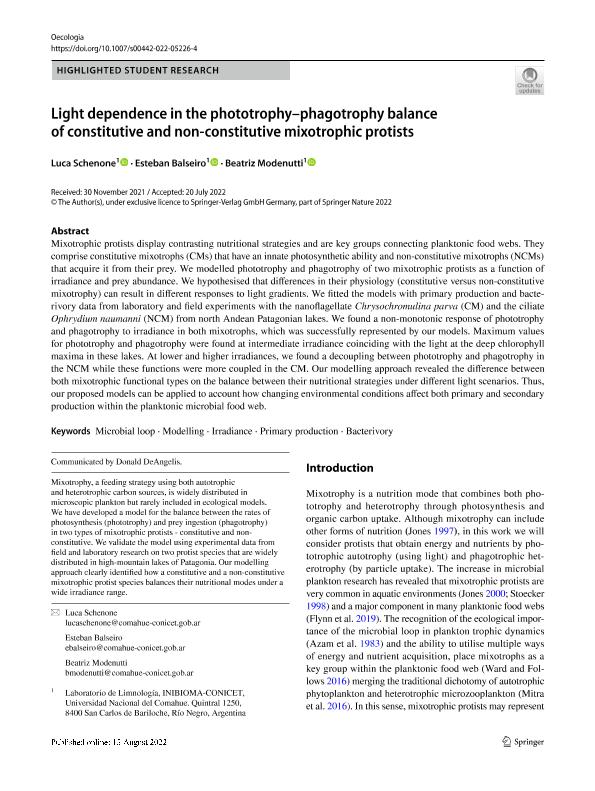Mostrar el registro sencillo del ítem
dc.contributor.author
Schenone, Luca

dc.contributor.author
Balseiro, Esteban Gabriel

dc.contributor.author
Modenutti, Beatriz Estela

dc.date.available
2023-07-05T10:56:17Z
dc.date.issued
2022-08
dc.identifier.citation
Schenone, Luca; Balseiro, Esteban Gabriel; Modenutti, Beatriz Estela; Light dependence in the phototrophy–phagotrophy balance of constitutive and non-constitutive mixotrophic protists; Springer; Oecologia; 200; 3-4; 8-2022; 295-306
dc.identifier.issn
0029-8549
dc.identifier.uri
http://hdl.handle.net/11336/202378
dc.description.abstract
Mixotrophic protists display contrasting nutritional strategies and are key groups connecting planktonic food webs. They comprise constitutive mixotrophs (CMs) that have an innate photosynthetic ability and non-constitutive mixotrophs (NCMs) that acquire it from their prey. We modelled phototrophy and phagotrophy of two mixotrophic protists as a function of irradiance and prey abundance. We hypothesised that differences in their physiology (constitutive versus non-constitutive mixotrophy) can result in different responses to light gradients. We fitted the models with primary production and bacterivory data from laboratory and field experiments with the nanoflagellate Chrysochromulina parva (CM) and the ciliate Ophrydium naumanni (NCM) from north Andean Patagonian lakes. We found a non-monotonic response of phototrophy and phagotrophy to irradiance in both mixotrophs, which was successfully represented by our models. Maximum values for phototrophy and phagotrophy were found at intermediate irradiance coinciding with the light at the deep chlorophyll maxima in these lakes. At lower and higher irradiances, we found a decoupling between phototrophy and phagotrophy in the NCM while these functions were more coupled in the CM. Our modelling approach revealed the difference between both mixotrophic functional types on the balance between their nutritional strategies under different light scenarios. Thus, our proposed models can be applied to account how changing environmental conditions affect both primary and secondary production within the planktonic microbial food web.
dc.format
application/pdf
dc.language.iso
eng
dc.publisher
Springer

dc.rights
info:eu-repo/semantics/openAccess
dc.rights.uri
https://creativecommons.org/licenses/by-nc-sa/2.5/ar/
dc.subject
BACTERIVORY
dc.subject
IRRADIANCE
dc.subject
MICROBIAL LOOP
dc.subject
MODELLING
dc.subject
PRIMARY PRODUCTION
dc.subject.classification
Ecología

dc.subject.classification
Ciencias Biológicas

dc.subject.classification
CIENCIAS NATURALES Y EXACTAS

dc.title
Light dependence in the phototrophy–phagotrophy balance of constitutive and non-constitutive mixotrophic protists
dc.type
info:eu-repo/semantics/article
dc.type
info:ar-repo/semantics/artículo
dc.type
info:eu-repo/semantics/publishedVersion
dc.date.updated
2023-06-29T10:08:40Z
dc.journal.volume
200
dc.journal.number
3-4
dc.journal.pagination
295-306
dc.journal.pais
Alemania

dc.description.fil
Fil: Schenone, Luca. Consejo Nacional de Investigaciones Científicas y Técnicas. Centro Científico Tecnológico Conicet - Patagonia Norte. Instituto de Investigaciones en Biodiversidad y Medioambiente. Universidad Nacional del Comahue. Centro Regional Universidad Bariloche. Instituto de Investigaciones en Biodiversidad y Medioambiente; Argentina
dc.description.fil
Fil: Balseiro, Esteban Gabriel. Consejo Nacional de Investigaciones Científicas y Técnicas. Centro Científico Tecnológico Conicet - Patagonia Norte. Instituto de Investigaciones en Biodiversidad y Medioambiente. Universidad Nacional del Comahue. Centro Regional Universidad Bariloche. Instituto de Investigaciones en Biodiversidad y Medioambiente; Argentina
dc.description.fil
Fil: Modenutti, Beatriz Estela. Consejo Nacional de Investigaciones Científicas y Técnicas. Centro Científico Tecnológico Conicet - Patagonia Norte. Instituto de Investigaciones en Biodiversidad y Medioambiente. Universidad Nacional del Comahue. Centro Regional Universidad Bariloche. Instituto de Investigaciones en Biodiversidad y Medioambiente; Argentina
dc.journal.title
Oecologia

dc.relation.alternativeid
info:eu-repo/semantics/altIdentifier/url/https://link.springer.com/10.1007/s00442-022-05226-4
dc.relation.alternativeid
info:eu-repo/semantics/altIdentifier/doi/http://dx.doi.org/10.1007/s00442-022-05226-4
Archivos asociados
